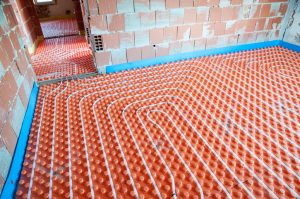
05 Jan All About Radiant Heating
Heating your home during the winter is a basic necessity, but there are several paths you could take to make your home nice and toasty. Radiant heating systems supply heat directly to the floor, wall panels, or ceiling panels via infrared radiation. If you would like an easy example of this kind of system, think of the heat you feel across the room from a hot stovetop.
There are several advantages to radiant heating systems when compared to traditional methods. Radiant heating is more efficient than baseboard heating and is usually more efficient than forced-air since it eliminates duct losses. It is also preferred by allergy-sufferers since radiant heating doesn’t contribute to dust and allergies like forced-air does. Hydronic systems (liquid-based) can also save you energy and money since they use little electricity and can run on a variety of energy sources, such as boilers and solar water heaters.
Radiant floor systems differ from panels and break down into three different types of systems:
- Air-Heated Radiant Floors: Since air cannot hold a lot of heat, these are not cost-effective for residential applications. Although they can be combined with solar air heating systems, the inefficiency of having a furnace pump air at night doesn’t make the daytime solar heating worth it.
- Electric Radiant Floors: These systems are most cost-effective when your electric utility company offers time-of-use rates and you can charge a significant thermal mass, like concrete, during off-peak hours. They also make sense to install in new home additions so you don’t have to extend your heating system to a new section of the house.
- Hydronic Radiant Floor: This system is the most popular and cost-effective radiant heating system. Hydronic systems work by pumping water from a boiler through a pattern of tubing laid under the floor. The cost of these systems can change depending on a variety of factors such as the size of your home and the floor covering.
Radiant panels can be heated either electrically or with hot water tubing. Although most radiant panels for homes are electrically heated and can be expensive to operate, they have the quickest response time of any heating technology. Since they can be controlled in each room, they can offer cost and energy savings as well. You also may be more comfortable the closer you are to the panels, as they function on a line-of-sight basis.
Radiant heating systems offer pros and cons when compared to other home heating systems. The experts at Wahl Heating, Cooling, and Plumbing can help you decide if radiant heating is right for your home.
For more information on radiant heating systems and repairs, #CallWahl at (412) 265-2662

